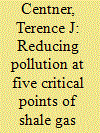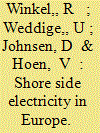|
|
|
Sort Order |
|
|
|
Items / Page
|
|
|
|
|
|
|
| Srl | Item |
| 1 |
ID:
166331


|
|
|
|
|
| Summary/Abstract |
The development of bioethanol can bring about socio-economic and environmental impacts. To support the sustainability analysis of bioethanol development and the decision-making on bioethanol promotion in Thailand, this study aims at assessing the socio-economic and environmental effects of bioethanol production using recursive dynamic computable general equilibrium (CGE) modeling. The assessment is carried out based on the bioethanol production targets in Thailand’s Alternative Energy Development Plan (AEDP) 2015, capturing cassava ethanol and molasses ethanol. Simulation scenarios are set up to incorporate the role of bioethanol support policies, such as tax reduction, production efficiency improvement, and widening the price gap between gasoline and gasohol, into the analysis. The results show that increasing bioethanol production together with improving the efficiency of feedstock cultivation is the most efficient way to enhance economic growth. However, the higher production and consumption would also lead to more irrigation water demand and air emissions. The presentation of bioethanol support policies’ role in promoting bioethanol along with widespread socio-economic and environmental effects focus are novel. Not only are the results useful for the decision-making towards sustainable bioethanol development, the methods presented in this study should also be a guideline for other socio-economic and environmental impact assessment schemes.
|
|
|
|
|
|
|
|
|
|
|
|
|
|
|
|
| 2 |
ID:
150668


|
|
|
|
|
| Summary/Abstract |
While the public and governments debate the advisability of engaging in shale gas production, the United States has proceeded to develop its resources with an accompanying remarkable increase in natural gas production. The development of shale gas has not been without problems, and some countries have decided that shale gas production should not proceed until more is known about the accompanying health issues and environmental damages. From experiences in the United States, careful consideration of five critical points relating to shale gas production can form the basis for developing strategies for reducing discharges of pollutants: (1) casing and cementing, (2) handling wastewater, (3) venting and flaring, (4) equipment with air emissions, and (5) seismic events. For each strategy, institutional responses to markedly reduce the risks of harm to people and the environment are identified. These responses offer state and local governments ideas for enabling shale gas resources to be developed without sacrificing public health and environmental quality.
|
|
|
|
|
|
|
|
|
|
|
|
|
|
|
|
| 3 |
ID:
150344


|
|
|
|
|
| Summary/Abstract |
In the context of reducing emissions from the transport sector, the EU Commission envisions a strong modal shift to energy efficient modes including maritime shipping and inland shipping, as an alternative for road transport. In view of the expected growth of the sector, the emissions from waterborne transport are a key concern. When at berth, ships typically use their auxiliary engines to generate electrical power for communications, lighting, ventilation and other on-board equipment. The extended use of vessels’ auxiliary engines augments greenhouse gas (GHG) emissions and air pollution in the adjacent ports, which are typically located in or near densely populated areas, thus leading to dangerous health and environmental effects. Shore Side Electricity (SSE) is an option for reducing the unwanted environmental impacts of ships at berth, i.e. GHG emissions, other air pollutants (NOx, SOx, PM) and noise of ships using their auxiliary engines. This paper quantifies the economic and environmental potential for SSE in Europe, through detailed estimation of in-port ships’ emissions and relevant energy demand, providing an insight of the expected barriers for implementation and formulating recommendations on policy actions that could accelerate the implementation of SSE in European harbors.
|
|
|
|
|
|
|
|
|
|
|
|
|
|
|
|
| 4 |
ID:
166397


|
|
|
|
|
| Summary/Abstract |
Hydrogen fuel cell electric vehicle technology is emerging as a promising option for the electrification of school or transit buses. For fuel cell electric transit buses, the U.S. government has set the fuel economy target at 8 miles per diesel gallon equivalent (MPDGE). However, life-cycle environmental implications of the 8 MPDGE target are currently lacking in the literature. In addition, no comparable target exists for fuel cell electric school buses.
|
|
|
|
|
|
|
|
|
|
|
|
|
|
|
|
|
|
|
|
|